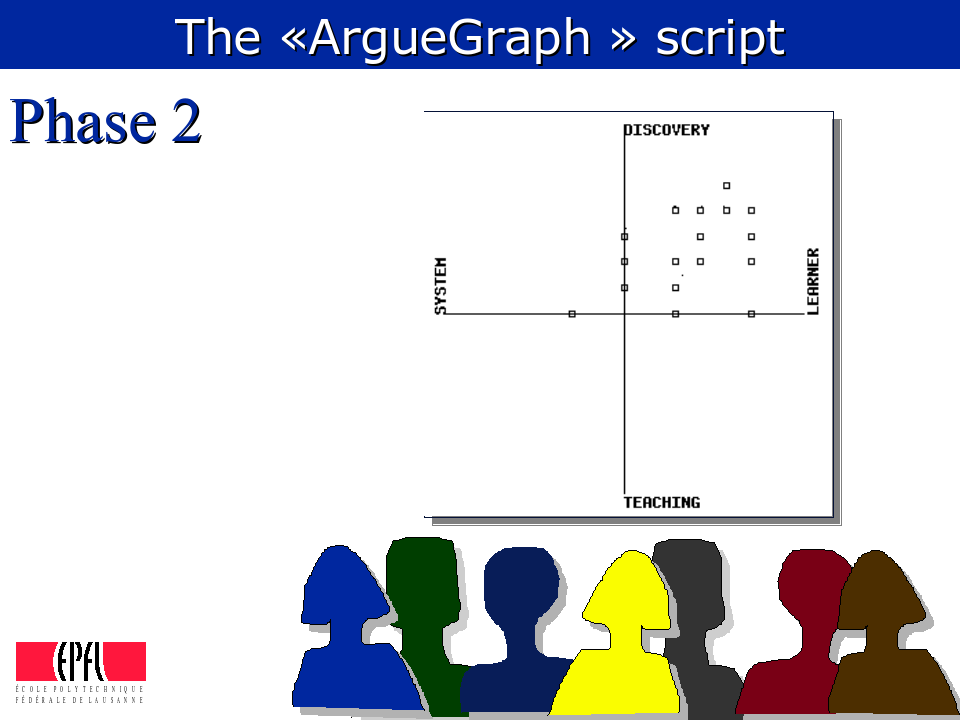ArgueGraph Script
Definition
ArgueGraph is the name of CSCL script invented by Pierre Dillenbourg. It has been described in several publications (see the references below).
The ArgueGraph script
The goal of the original ArgueGraph script (Jermann & Dillenbourg, 1999) was that students learn to relate courseware design choices with the underlying learning technologies. Since then, it has been used in other contexts.
The script is based on a simple multiple-choice questionnaire produced by the teacher. For each answer of each question, the teacher determines X and Y values that will be summed to compute the students' opinion in a two-dimensional space. This script includes five steps:
- Phase 1
Each student takes the quiz on-line. For each choice, the student enters an argument in a free-text entry zone.
- Phase 2
The system produces a graph in which all students are positioned according to their answers. Students look at the graph and discuss it informally. The system or the tutor forms pairs of students by selecting peers with the largest distance on the graph (i.e., that are most different).

- Phase 3
Pairs answer the same questionnaire as in step 1 together and again provide an argument. They can read their individual previous answer.
- Phase 4
For each question, the system computes the answers given individually (phase 1) and collaboratively (phase 3). The tutor uses these data during a face-to-face debriefing session.
- Phase 5
Each student writes a synthesis of all arguments collected for a specific question. The synthesis has to be structured according to the theoretical framework introduced by the teacher during the debriefing (phase 4)
Dillenbourg, P. (2002)
This script has been successfully used at [TECFA] to teach the relationship between learning theories and the design of educational software (Jermann & Dillenbourg, 1999). It can be generalized to conceptual domains in which multiple theories co-exist.
- The script integrates face-to-face and online activities.
- The script is not 100% collaborative: it includes a peer interaction phase (3), but also individual phases (1 and 5) and a collective phase (4). A collective phase involves all students in the class.
- The design rationale for this script is to create conflicts among students and engage them into interactions to resolve the conflict.
- We tested two versions of this script, one where all students were in the computer room and another one where they used the system at distance for phases 1 to 3. The two versions used different CSCL environments. The latter did not work very well for two reasons. First, the interface for phase 3 enabled students to avoid conflict resolution by weighting their degree of agreement with each proposal instead of being force to choose one and only one proposal. Second, the pairs who argued (phase 3) long before the debriefing (phase 4) were much less involved in the debriefing discussion than those who argued just before. In other words, the efficiency of this script is not only influenced by the choice of activities but also by factors such as the ergonomics of the environment (Jermann & Dillenbourg (2003) and the timing of phases, not to mention the quality of the questionnaire
Kobbe's description
This script can be described as follows in the Kobbe/Kaleidoscope framwork (see CSCL script):
References
- Dillenbourg, P. (2002). Over-scripting CSCL: The risks of blending collaborative learning with instructional design. In P. A. Kirschner (Ed.), Three worlds of CSCL. Can we support CSCL (pp. 61-91). Heerlen: Open Universiteit Nederlan
- Dillenbourg, Pierre and Patrick Jermann (in press), Designing Integrative Scripts.
- Jermann, P. & Dillenbourg, P. (1999) An analysis of learner arguments in a collective learning environment. Proceedings of the third CSCL Conference, pp. 265-273, Stanford, Dec. 1999.
- Jermann, P., & Dillenbourg, P. (2003). Elaborating new arguments through a cscl scenario. In G. Andriessen, M. Baker, & D. Suthers. (Eds.), Arguing to learn: confronting cognitions in computer-supported collaborative learning environments. Computer-Supported Collaborative Learning Series. Amsterdam: Kluwer.
- Kobbe, Lars (2006). Framework on multiple goal dimensions for computer-supported scripts, Kaleidoscope, D21.2.1 (Final). PDF (TeLearn archive)